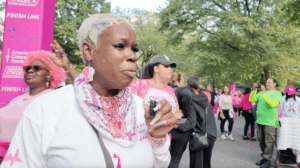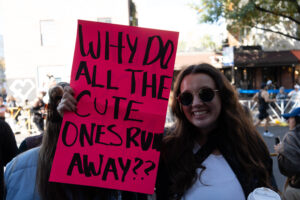
Intersection of W17th St & 8th Ave, approximate location of Halley Kate’s alleged assault |
Photographed by Lauren O’Neal
NEW YORK- It started out as a typical morning for Halley Kate, a TikTok influencer with more than a million followers. She was strolling through the bustling streets of lower Manhattan in March of 2024, running errands, and looked down at her phone to tap out an email.
The violent attack caught her completely off guard. Suddenly, she felt a blow on the left side of her head and fell to the ground. Her assailant was a man who had allegedly attacked several others in a series of hate crimes in Manhattan last spring. Kate described the attack in a TikTok video that soon went viral.
“I blacked out for a second,’’ Kate said in the video, “but then when I got up, he was screaming at me.”
The string of hate crimes in Manhattan was one of a series of violent attacks targeting women in the United States and globally, highlighting what some experts describe as the normalization of gender-based violence on the streets as well as online.
“ This hatred of women underpins a lot of that violence against women in society,” University of Wisconsin Professor Mariel Barnes said.
The attack against Kate occurred a week prior to another spate of hate crimes targeting women in New York City. Daquan Armstead was arrested and charged with punching seven women in what the Manhattan District Attorney’s Office described as a “series of misogynistic attacks.”
Some scholars say that the normalization of this kind of violence against women has become increasingly prevalent online. They point to the rising popularity of the “manosphere,” a collection of websites, blogs, and online forums that often promote misogyny.
Barnes, an assistant professor at University of Wisconsin, has studied the manosphere and found that the number of anonymous blogs and websites that promoted violence against women began growing in 2008 and peaked in 2013 and 2014 before starting to decline.
While some might think that this indicates a decline in misogynistic ideologies online, Barnes says that is not the case.
Instead, she believes that misogyny became more integrated into mainstream social media as such views became increasingly normalized following the election of President Trump in 2016.
“These ideas are actually transferring to the mainstream, and so you no longer need a blog to talk about your hatred of women,’’ Barnes said. “With the rise of Donald Trump, hatred of women has kind of been like ‘sane’ washed and gone mainstream.”
Sometimes, men espousing such beliefs turn to violence. Several high profile mass shooters have espoused misogynistic ideologies in recent years. In 2014, Elliot Rodger declared “war on women” before shooting and killing six people and injuring 14 others in Isla Vista, California. In his manifesto, which he posted on YouTube, he said that wanted to punish women for rejecting him and to target conventionally attractive men as well.
In the years that followed, Rodgers became a celebrity in the Involuntarily Celibate Community, a community of heterosexual men who blame women and society for their inability to form romantic relationships. The Involuntarily Celibate Community is described by the Anti-Defamation League as the most violent element in the manosphere. Rodgers’ manifesto inspired other men, including Alek Minassian, who killed 11 people and injured 15 others by driving a van into a crowd in Toronto in 2018.
That same year, Scott Beierle opened fire in a hot yoga studio in Tallahassee, Florida, killing two women and injuring four others. The shooting was a pre-planned attack after “a lifetime of misogynistic attitudes,” according to the Tallahassee Police Department. Beierle had posted numerous YouTube videos, referring to Rodger and detailing his own frustration at not having a girlfriend.
Scholars and advocacy groups are increasingly recognizing misogyny as a motivating factor in mass shootings. In 2020, the International Center for Counter Terrorism recognized misogyny as an “animating” ideology for acts of mass violence. However, the Southern Poverty Law Center and the National Consortium for the Study of Terrorism and Responses to Terrorism have tracked misogyny as a motive for terrorism since 2018.
While gender-based crimes are considered hate crimes federally and in 35 states within the United States, some scholars point to challenges in the reporting and tracking of such crimes. In 2023, the FBI reported that gender-based hate crimes accounted for fewer than 1 percent of the 11,862 hate crimes reported that year.
Rebecca Stotzer, a human behavior and policy professor at the University of Hawaii, explained that the challenge facing law enforcement is that they must prove that the primary motivation for the crime stems from the hatred of women, as opposed to other motivations.
That “ complicates things” in individual cases, said Stotzer, even though “we all see the animus and the hatred that some people have for women.”
Shonna Trinch, an anthropology professor at John Jay College of Criminal Justice, has been studying how the criminal justice system tracks violence against women. She has found many inconsistencies in reporting, including violence being minimized in some cases while in other cases violence appeared to be exaggerated.
“I think it’s problematic, not just for the individual who’s trying to get something done or accomplished in court, but for the courts and for legal jurisprudence itself,” Trinch said.
The District Attorney’s Office did not respond to multiple requests for comment.
While gender-based hate crimes are reported to be only a small percentage of hate crimes committed in the United States, rates of gender-based hate crimes continue to rise. In a report by the US Department of Justice, gender-based hate crime incidents have almost doubled in 2019 compared to 2016.
The increase in gender-based hate crimes reflects, in part, the rise of misogynistic ideologies online, Barnes said.
Such violence against women – whether hate crimes or domestic violence – is no longer viewed as unusual in some circles. It is a constant concern, a far too frequent part of daily life, according to Dani Macorkindale, a junior at New York University.
“I’ve ran from men on the street before,’’ said Macorkindale, explaining why the string of hate crimes targeting Kate, the TikTok influencer, and other women has not affected her. “I’ve had stuff happen to me in broad daylight, so it doesn’t change my perception.”
“It’s almost like a party conversation sometimes,” she said, describing how her friends casually share their accounts of unwanted attention or violence from men with each other, because it is so prevalent.
Trinch said that she believes domestic violence should be considered a hate crime, too. “Violence against women is a constant hate crime; we don’t talk about it as a hate crime, though,” she said.
One in three women has been subjected to violence globally, according to the United Nations. To combat this issue, ElsaMarie D’Silva, social entrepreneur and expert on crowdsourcing data to address violence against women, created the Red Dot Foundation, a non-profit organization that trains, educates, and promotes policy changes to protect women around the world from gender-based violence.
The most important factor in combating violence against women is through education, according to D’Silva. “ They are not aware of their rights,’’ she said. “We don’t talk about it, so there’s a taboo around this issue. Also, you’re often made to believe it is your fault.”
The Red Dot Foundation has provided more than 13,000 people with bystander training so they know how to safely intervene when gender-based violence occurs. D’Silva said bystander training has been useful in combating violence against women as it has made people more confident in supporting victims in crisis.
“Almost everyone said that they did not realize that there were so many different ways or strategies to intervene without putting themselves at risk,” said D’Silva.
In response to the string of hate crimes targeting women in New York City, the Manhattan District Attorney’s Office has charged and indicted two suspects believed to be responsible for the misogynistic attacks.
Two days after Kate, the social media influencer, was attacked, she learned that her assailant had been arrested. The accused perpetrator was Skiboky Stora, a 40-year-old man from Brooklyn. He has been charged with three counts of Assault as a Hate Crime.
The court proceedings are continuing for Kate’s alleged assault. Stora will return to court on May 19th, representing himself as his defense attorney.
“I personally am not going to revolve my life around that one incident and be afraid to walk around the streets,” Kate said in a TikTok video. “But I do think this serves as a good wake up call just to be a little bit more aware of my surroundings.”








